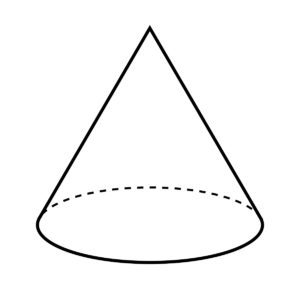 A cone is a geometric shape with three dimensions. The base is rounded, but not necessarily a circle, and tapers smoothly to a point called the apex. Cones are smooth and have no sides, but rather a curved surface. Pyramids also taper smoothly, but they have angular sides with corners. Although, there are circular pyramids that can easily be mistaken for a cone.
A cone is a geometric shape with three dimensions. The base is rounded, but not necessarily a circle, and tapers smoothly to a point called the apex. Cones are smooth and have no sides, but rather a curved surface. Pyramids also taper smoothly, but they have angular sides with corners. Although, there are circular pyramids that can easily be mistaken for a cone.
Perfect cones are only seen in man-made manufacturing such as at the apex of a large building or waffle cones used for ice cream. Natural cones can be seen all around the world. Mountains, remarkably, are a great example of a natural cone.
The dimensions of a cone are relatively easy to find. Unlike most geometric shapes, cones are three dimensional. This means instead of simply finding the area isn’t enough to discover the full dimensional measurements.
In a right circular cone, only radius and height are needed to find the volume. An oblique circular cone will need a measurement of radius, height, and area to find volume.
Volume of A Cone
By looking at a piece of paper lying on a desk the width and height would be visible. These two dimensions could be measured to show the area of the paper. If a box were placed on the same table, measurements of length, width, and height would be needed to discover the amount of space taken up by the box. The paper is measured in area, whereas the box is measured in volume. That extra dimension makes a big difference in how the shapes are measured and perceived.
To make things even more complicated, there are different formulas to find the volume of right cones and oblique cones. Right cones are much easier to solve for. The formula is V = 1/3 Ab x H
V is the volume, Ab is the area of the base, and H is the height measured from the center of the base to the apex.
The next step is to use the radius to find the area of the base. Using the formula of Ab = Pi x R2 will solve for the area of the base. If the radius is four inches, the formula would be set up to look like this, Ab = 3.14 x 42. The answer would be 3.14 x 16 = 50.24. We’ll give the cone a height of eight inches to make things easy.
All that’s left is to put the values into the formula. It should be set up too look like this, V = 1/3 50.24 x 8. Solving this formula will give the volume of the cone. Given the values of Ab and H, the volume of this cone would be 132.64.
Using this formula only works for right cones, and oblique cone will have a different formula. This is because the area of an oblique cone must be measured along the curve of the outside of the shape. The height, length, base radius, and deviation must all be measured to calculate volume. For each dimension added to a shape, the formula to solve the volume becomes more complicated.